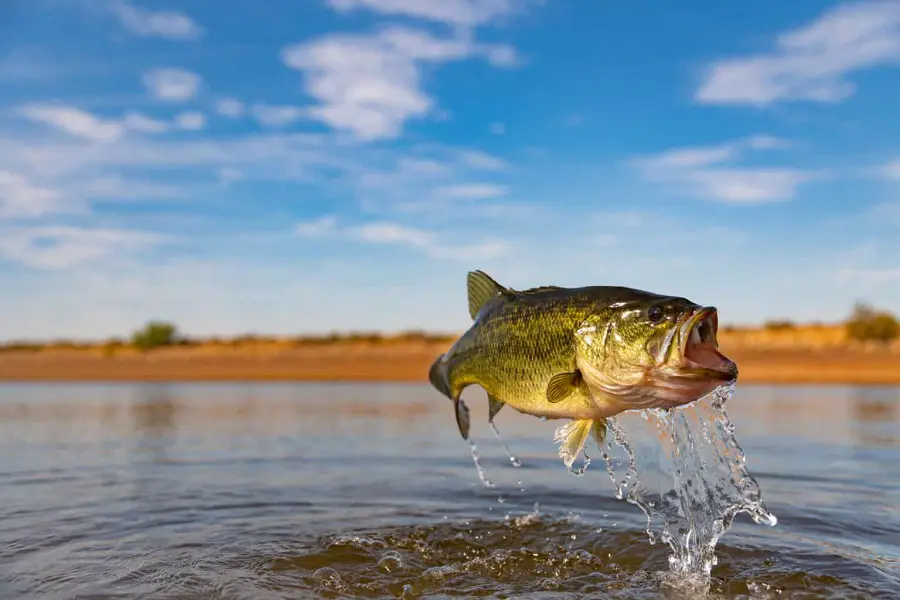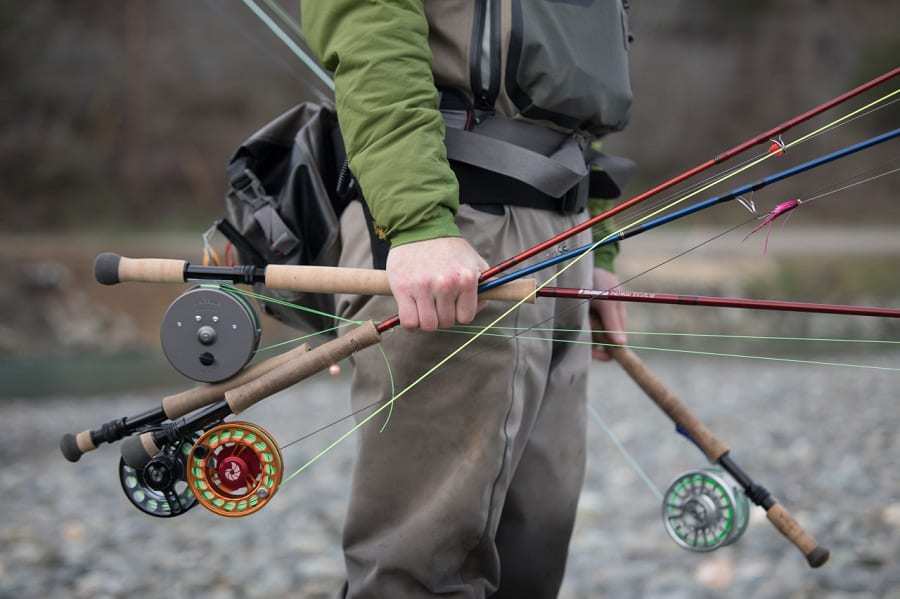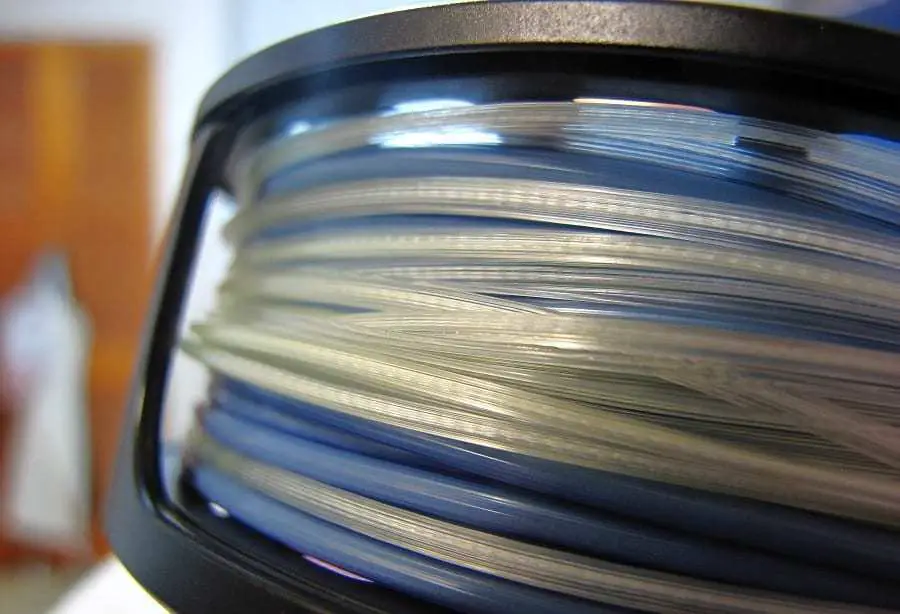Have you found yourself fishing, unable to tell what bass you have caught? Perhaps you are getting confused between Smallmouth and Largemouth bass and need some assistance.
Or maybe you are curious and want to know more? Whatever your reason might be, we have the answer for you!
We know how challenging it can be, even for experienced anglers, to tell these fish apart. They can be found in similar locations and environments, with similar colors and markings making it almost impossible to identify them!
You find yourself embarrassed next to more experienced fishers needing assistance to identify your catch of the day. Well, no more! Today we are here with a complete guide to these fish! Keep reading to find out all about Smallmouth and Largemouth bass.
We will walk you through their similarities and differences to help identify these fish and offer tips to improve your chances of catching a bass.
A Common Case of Misidentification
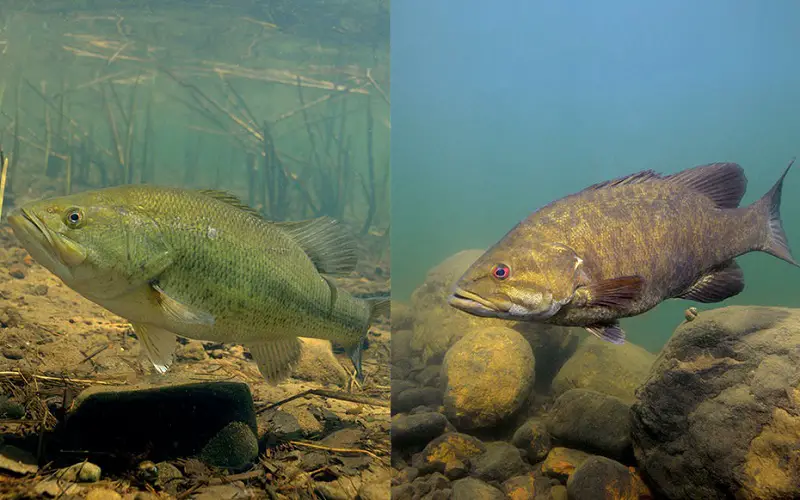
When it comes to Smallmouth and Largemouth Bass, misidentification is a common issue!
They can be challenging to tell apart, with many similarities in their appearance; anglers can often pull in a fish and be stumped as to which one it is!
You can find yourself in new waters, unsure what bass is dangling off your line. Some anglers can still find themselves stumped despite the wealth of information online and tips to identify them.
And it’s the beginners that struggle far more than the seasoned anglers out there. Pro anglers always seem to just know which type of fish they have, and it can be embarrassing when you stand next to them stumped.
But it happens to the best of us, especially when we are starting out! So to help you identify which bass is which, we have put together this guide.
Misidentification is a common occurrence in the angling world and is nothing to be ashamed of!
Keep reading to see where these fish are similar and different to learn more about them and tell a Largemouth and Smallmouth apart today!
Appearance

The Largemouth and Smallmouth bass have similarities and differences that you can use to tell these fish apart.
To help you separate the two, we have a list of their similarities and differences you can use. Keep reading to see the different features of the fish and where the two are similar and different.
Size
As their names suggest, there is a size difference between Smallmouth and Largemouth bass. Largemouths tend to grow a lot bigger than Smallmouths, being almost twice their weight at 20 lbs!
Largemouths are far bigger than Smallmouths and feature Largemouths, helping them grow bigger faster than a Smallmouth does. And with this larger size comes more dominance in the water. Largemouths are better adapted to eating other fish and securing their food source; you wouldn’t want to be a small fish competing with them!
Mouth
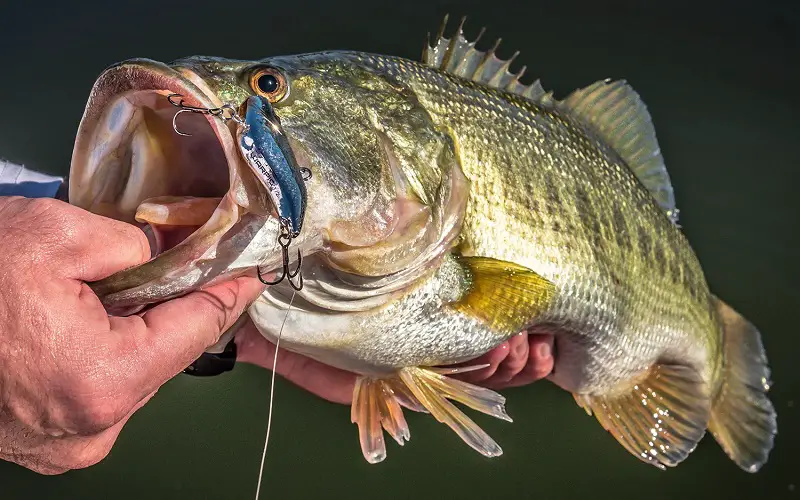
As we mentioned above, Largemouths have larger mouths than Smallmouths. Ever wondered where they get their name from? It’s down to the size of their mouths! A Largemouth has a larger mouth with its upper jaw extending past their eyes!
A Smallmouth’s jaw is in line or stops just before the eye. After removing the hook, you can turn your bass on its side to quickly check the mouth if you haven’t identified which type of bass you have caught yet. It’s not always a precise method, but a handy one to be aware of if you want to turn your fish quickly and check.
Fins
The fins are another way you can tell the fish apart. Largemouths have a break between their dorsal fins, whereas Smallmouths don’t. The dorsal fin runs along the spine on the top of the fish, so be sure to keep an eye out for that!
Color
Another way to tell these fish apart is by their color. Largemouths have the nickname ‘Green Bass’ due to their green color, and Smallmouth or ‘Brown Bass’ are known for their brown color. However, the color on both fish can differ slightly, but you can use these colors to indicate the type of fish.
Body and scales
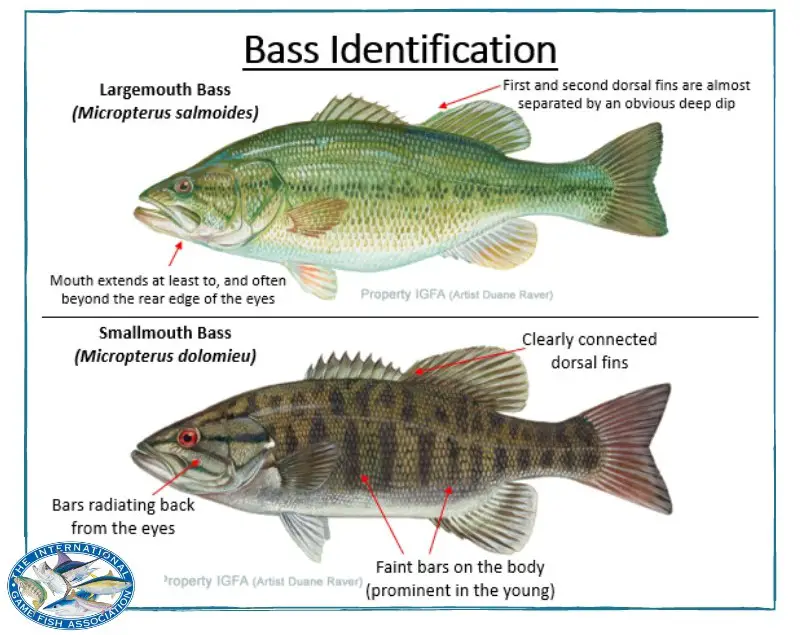
Largemouths come with dark horizontal lines over their body that you can use to identify them; Smallmouths, on the other hand, come with straight vertical lines that mark their sides. This isn’t always the case, but it can help you identify these fish quickly while fishing.
Other
Once you have caught a few of these basses, Smallmouths, it will be easier to identify which is which. But there are some points of debate that you should be aware of before heading off with your fishing line.
The first is that some anglers will refer to the appearance of bass fish and their identifying features differently. A common one is Largemouths, described as having blotches rather than stripes.
The more time you spend with other anglers, the more little differences like this you will hear about and become familiar with. It’s important to remember the differences we mentioned earlier and to take your time when identifying the fish.
If you do run into any difficulties, you can ask a more experienced fisherman or angler nearby. Usually, people are more than happy to help beginners or those unsure to identify their fish.
After all, we were all beginners once! Alternatively, you can take a picture of the fish and post it on forum sites that help you determine the species and type of fish you have.
This is a fantastic way to meet other anglers, too, and find a community of helpful fishers!
Location and habitat
Although there is some overlap, these fish tend to enjoy different habitats and locations. Let’s take a look at these now, so you know where to go hunting for these fish!
Largemouth
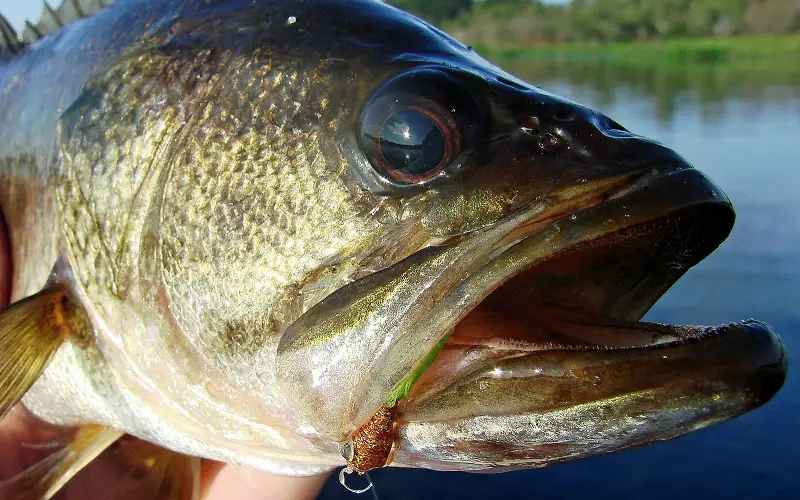
Largemouth bass love cover! Whether it’s stumps and rocks, weed beds, grasses, or brush piles, they are there if there’s thick cover!
They love the cover and don’t even move when they feed, which means you can easily find these fish! Even in murky water, you can find these fish.
Instead of looking for the fish itself, just find the cover they’re hiding in, and you have a good chance of catching these fish!
You will find that Largemouth avoid strong currents in rivers, and the lazy hunters will usually rest in current breaks until they spot a fish to attach.
Find yourself a sheltered break with plenty of thick covers next to a fast current, and there’s a good chance you can catch a Largemouth bass here!
You can find Largemouths in most of the US following introduction schemes. Originally they were native to the eastern and central US, along with parts of Mexico.
Now, the fish is the state fish of Alabama, Florida, Georgia, and Mississippi. You can find the largemouth in the same areas as the Smallmouth!
Smallmouth
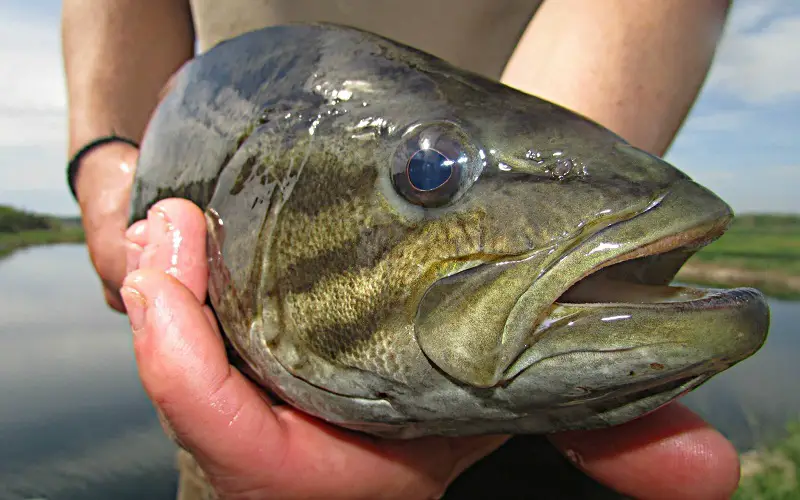
Like Largemouths, Smallmouth Bass also enjoy the cover. But they are unlikely to enter the cover. Instead, these fish hunt around the cover, especially deep and rocky areas.
These fish also tend to chase baitfish into open water, meaning you can spot them easily in clean water.
When fishing for these, ignore breaks and place your cast right into fast-moving water instead, and this will increase your chances of catching a Smallmouth Bass.
Smallmouths are native to the Great Lakes, Hudson, and Mississippi river basins. You can also find them in the Northern parts of the US and Canada, where they were entered illegally. They have a few different regional names like ‘brownie’ and ‘smallie’ to identify them in these rivers.
Behavior
You can also observe the behavior of these fish to tell them apart. Smallmouths tend to be more agile and jump out of the water compared to larger fish!
You can get a thrill when angling, and these pop out of the water to say hello! They can be unpredictable too and offer more of a fight, something many anglers enjoy!
Smallmouths are often a favorite in tournament fishing too. Their small size and increased agility mean they are considered a more difficult catch!
Food
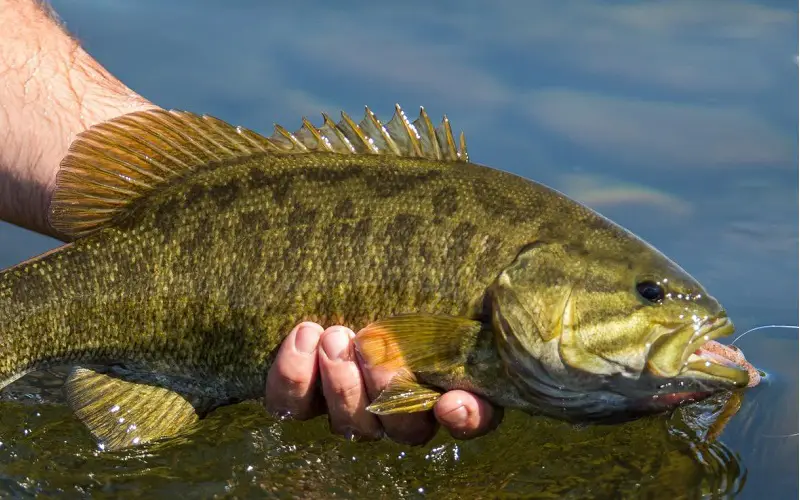
Both Largemouth and Smallmouth bass have a wide and varied diet.
They both feed on similar food sources like shad, shrimp, scuds, and salamanders and use this as a large portion of their diet. However, Largemouth bass utilizes its size and skills to prey on larger fish too.
What these fish eat does vary depending on their age. Young and juvenile fish tend to eat algae while they are growing and developing. As they age and reach maturity, these bass species will eat fish and other insects.
Invasiveness
When it comes to Largemouths, they tend to be quite invasive.
Adult largemouths are considered predators in their environments and occupy water with little or no cover, allowing them to spot and catch their prey easily.
These fish are excellent at catching open-water baitfish, wiping out whole populations sometimes!
Smallmouths are less invasive than Largemouths, and the reason for this is usually attributed to their hibernation periods in the winter and migration patterns. That said, these fish can still prey and catch others when needed!
Spawning
Bass fish will reach sexual maturity at roughly a year and usually spawn in the spring when the weather starts to warm up slightly.
Depending on the climate, spawning can last through the springtime and into the summer! This usually happens in Southern states where we see warmer temperatures.
Once the females have laid their eggs, males will guard the nests.
These are usually small mounds of gravel, mud, or sand and will be located on the bottom of the lakebed. In the following spring, you can cash in and catch some great bass!
You will find that in the winter period, Smallmouths will hibernate and be hard to find. Instead, use this time to target Largemouths! Smallmouths are also likely to spawn in disturbed waters or those too hot for them, and they tend to be fussier than the Largemouths!
Best season to fish

When fishing for bass, you want to ensure you are going at the best time!
There’s no point going if you aren’t going to see any fish. The best season will vary depending on where you are fishing.
Bodies of water will have their peak seasons, usually determined by climate, depth, vegetation, and other factors. But there are a few general rules you can follow to fish at the best time!
For largemouths, summer is best.
They spend their time in shallow bays and creeks where they will nestle in a spot with cover and access to a structure. Because of this, you can find them easily in the summer.
Some anglers argue that you need overcast and drizzly days to find Largemouths lurking in murky water, but we would avoid it if you don’t enjoy fishing in this weather.
Another factor to consider is the wind. If there’s a light breeze, that’s fine. But if there is anything stronger, the fish are likely to roam in the grass instead of staying put, making it harder for you to track them down!
For Smallmouth, springtime is best! Here they are in the shallows and spawning before heading into deep water when the weather becomes hotter.
You will be hard-pressed to find a Smallmouth in late summer, and these fish hunt in the open and are usually solo fliers.
If you missed the opportunity in the spring, you could try again in the fall when these fish head back to the shallows. You can spot them easily then and will have the best success on bright days with calm waters. These fish prefer clear and open waters, meaning you can spot them easily too! A light breeze is fine, but anything stronger will make fishing difficult.
Gear Selection: Smallmouth Vs. largemouth
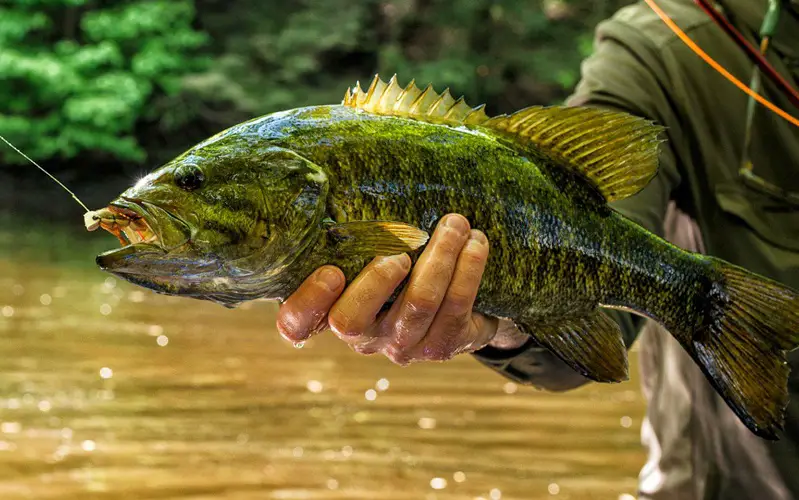
Now that we have covered the similarities and differences between Smallmouths and Largemouths let’s look at the gear you need.
Knowing what to use and why will help you improve your catch rate and ensure that you get the bass you want!
And when it comes to catching Largemouth and Smallmouths, there are some different approaches you need to take. Let’s look at them in closer detail now.
Largemouth
Largemouths require a firmer approach to your gear set-up, as they tend to occupy areas with heavy cover. You will be better off using baitcasting rods compared to spinning rods.
The added power on a baitcasting rod will allow you to get through any underwater obstacles and provide you with increased control when casting.
You don’t need anything fancy; a mid-price point medium action rod will be more than suitable. It’s best to add a jig or crankbait as your lure.
Use a fluorocarbon or braided line to hit bottom and bump across the water. This will create ample distraction to draw in the fish and have a successful fishing experience.
Smallmouth
For Smallmouth, baitcasters and spinning rods with medium action will work well.
You might want to make some changes when targeting Smallmouth bass as you will be working in fast-moving waters and currents, chasing the fish.
You will want a strong line to handle this and a lure that won’t sink too deep.
You don’t want it to sink lower than the bass itself. When dressing the lure, you can do so similarly as both species have a similar diet.
Be sure to check what’s in the water and what the bass are eating before rigging up. Doing so will help increase your chances of a catch.
Conclusion
And just like that, we have come to the end of our bass journey today. As you can see, Smallmouth and Largemouth bass are similar in many ways, and fishing for them can be a similar process.
However, there are a few differences you should keep your eye out for when fishing.
It can take time to tell them apart, but after a few times fishing for bass, you too will be able to differentiate between Smallmouth and Largemouth bass!
References:


